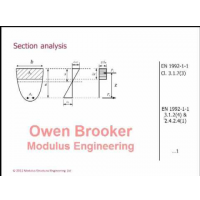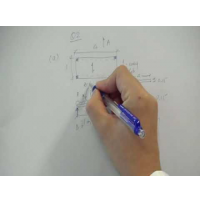Concrete
The selection of the type of concrete is frequently governed by the strength required, which in turn depends on the intensity of loading and the form and size of the structural members. For example, in the lower columns of a multi-storey building a higher-strength concrete may be chosen in preference to greatly increasing the size of the column section with a resultant loss in clear floor space.
The concrete strength is assessed by measuring the crushing strength of cubes or cylinders of concrete made from the mix. These are usually cured, and tested after 28 days according to standart procedures. Concrete of given strength is identified by its “class” - a Class 25/30 concrete has a characteristic cylinder crushing strength (fck) of 25 N/mm2 and cube strength of 30 N/mm2. Table shows a list of commonly used classes and also the lowest class normally appropriate for various types of construction.
Exposure conditions and durability can also affect the choise of the mix design and the class of concrete. A structure subject to corrosive conditions in a chemical plant, for example, would require a denser and higher class of concrete than, say, the interior members of a school or office block. Although Class 42.5 Portland cement would be used in most structures, other cement types can also be used to advantage. Blast-furnace or sulfate-resisting cement may be used to resist chemical attack, low-heat cements in massive sections to reduce the heat hydration, or rapid-hardening cement when a high early strength is required. In some circumstances it may be useful to replace
some of the cement by materials such as Pulverised Fuel Ash or Ground Granulated Blast Furnace Slag which have slowly developing cementitious properties. These will reduce the heat of hydration and may also lead to a smaller pore structure and increased durability. Generally, natural aggregates found locally are preferred: however, manufactured lightweight material may be used when self-weight is important, or a special dense aggregate when radiation shielding is required.
The concrete mix may either be classified as “designed” or “designated”. A “designed concrete” is one where the strength class, cement content, are specified. With a “designated concrete” the producer must provide a material to satisfy the designated strength class and consistence (workability) using a particular aggregate size. “Designated concretes” are identified as RC30 (for example) based on cube strength up to RC50 according to the application involved. “Designed concretes” are needed in situations where “designated concretes” connot be used on the basis of durability requirements (e.g. chloride-induced corrosion). Detailed requirements for mix specification and compliance are given by BS EN206 “Concrete -Performance, Production, Placing and Compliance Criteria” and BS8500 “Concrete – Complementary British Standard to BS EN206”.

